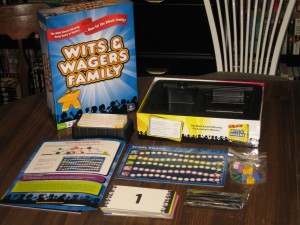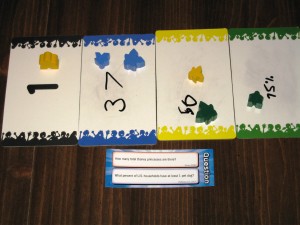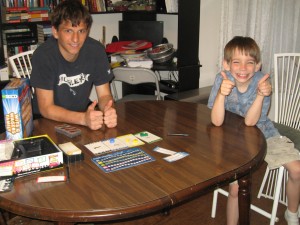When I was purchasing Say Anything and Say Anything Family, I saw both Wits & Wagers and Wits & Wagers Family and thought I’d give them a try as well. I normally don’t buy games without doing research first, but they looked like a lot of fun.
*Editor’s Note: You can play with more than five players, if you pair up in teams.
Both Wits & Wagers and Wits & Wagers Family task players with answering trivia questions via a marker and markerboard in a manner similar to the Say Anything series. Like Say Anything, Wits & Wagers is geared more towards adults whereas the family version is more kid friendly. Unlike Say Anything & Say Anything Family, both of the Wits & Wagers editions play a little differently and have different components, so I’ll be reviewing them separately.
Important: Everything you are about to see below represents the Wits & Wagers Family Edition.
Components
Markerboards & Markers – Each player will be using these to write down their answers whenever trivia questions are read.
Meeples – These small people figures are used during bidding. There is one large and one small meeple of each player color.
“1” Board – All answers in Wits & Wagers Family come in the form of numbers and are arranged numerically from lowest to highest. The “1” board is placed on the left end of the table, serving as the starting point for numerically ordering answers.
Trivia Cards – These are read for players to answer via their marker and markerboard.
Scoreboard – Players keep track of their scores on this markerboard.
Setup & Gameplay
All players receive a marker, markerboard, and two meeples of their color. The “1” board is placed on the far left of the table. Assign a person to be the scorekeeper and to read the trivia cards, or have players take turns.
On the beginning of a round, a player picks a trivia card and reads the question. All questions ask for some sort of numeric answer, so all players only need to write a number on their markerboard. Players hide their answers until everyone is done. Once everyone says they are done, they place their markerboards into the center of the table, arranging them numerically from lowest to highest, using the “1” board as a starting point. In case of ties, the boards in question are placed next to each other and count as one answer during bidding.
Once this is done, players will place their meeples on the answers that they think are correct. The larger meeple is worth two points and the smaller meeple is worth one point. Players can split their meeples among the answers however they wish and the “1” board can be utilized as well.
Once all players have bid, the answer is read. The closest answer without going over wins, and scoring occurs as follows:
1 Point – Having a small meeple on the winning answer.
2 Points – Having a large meeple on the winning answer.
1 Point – Being the player who wrote the winning answer. If the winning answer had a tie, both players receive the point for having the winning answer.
At most, players can score four points per round.
Play continues until the scoreboard reaches its end, in which case the points are tallied. The person with the most points at the end of the game wins!
The Review
Of the two versions, this one is a lot easier to play. The rules and the overall gameplay is simplified so that even kids can play this game on their own without much supervision. Parents won’t have to worry about chips and calculating payouts when playing this version.
Like the standard version, the questions are designed to be almost impossible…though the kids did know a few of the questions, earning them a lot of points. Since the questions are answers that players more than likely won’t get, there is some strategy involved in choosing just the right “Price is Right” bid. You don’t want to pick a number too low, but you also don’t want to pick a number too high to where you might go over. At least with a low number, there’s the possibility of others going over and your answer being the closest without going over.
Both Anthony (16) and Vinnie (11) seemed to enjoy themselves. I personally enjoyed picking out questions that centered around their personal interests. Vinnie’s poker face hasn’t developed yet, so I got to see his expression light up when I asked an animal related question that he might actually know the answer to.
Overall, this game was worth the price, in my opinion. Get this version if you’re playing with young kids, as the bidding mechanic of the standard version may confuse them. I’d advise investing in dry erasers as well so that you can erase answers from the markerboards on a regular basis without any trouble.
Be on the lookout for a review of the standard version, hopefully coming soon!
Final Verdict: 9/10
—



